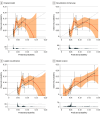External Validation of Brief Resolved Unexplained Events Prediction Rules for Serious Underlying Diagnosis
- PMID: 39680379
- PMCID: PMC11791710
- DOI: 10.1001/jamapediatrics.2024.4399
External Validation of Brief Resolved Unexplained Events Prediction Rules for Serious Underlying Diagnosis
Abstract
Importance: The American Academy of Pediatrics (AAP) higher-risk criteria for brief resolved unexplained events (BRUE) have a low positive predictive value (4.8%) and misclassify most infants as higher risk (>90%). New BRUE prediction rules from a US cohort of 3283 infants showed improved discrimination; however, these rules have not been validated in an external cohort.
Objective: To externally validate new BRUE prediction rules and compare them with the AAP higher-risk criteria.
Design, setting, and participants: This was a retrospective multicenter cohort study conducted from 2017 to 2021 and monitored for 90 days after index presentation. The setting included infants younger than 1 year with a BRUE identified through retrospective chart review from 11 Canadian hospitals. Study data were analyzed from March 2022 to March 2024.
Exposures: The BRUE prediction rules.
Main outcome and measure: The primary outcome was a serious underlying diagnosis, defined as conditions where a delay in diagnosis could lead to increased morbidity or mortality.
Results: Of 1042 patients (median [IQR] age, 41 [13-84] days; 529 female [50.8%]), 977 (93.8%) were classified as higher risk by the AAP criteria. A total of 79 patients (7.6%) had a serious underlying diagnosis. For this outcome, the AAP criteria demonstrated a sensitivity of 100.0% (95% CI, 95.4%-100.0%), a specificity of 6.7% (95% CI, 5.2%-8.5%), a positive likelihood ratio (LR+) of 1.07 (95% CI, 1.05-1.09), and an AUC of 0.53 (95% CI, 0.53-0.54). The BRUE prediction rule for discerning serious diagnoses displayed an AUC of 0.60 (95% CI, 0.54-0.67; calibration intercept: 0.60), which improved to an AUC of 0.71 (95% CI, 0.65-0.76; P < .001; calibration intercept: 0.00) after model revision. Event recurrence was noted in 163 patients (15.6%). For this outcome, the AAP criteria yielded a sensitivity of 99.4% (95% CI, 96.6%-100.0%), a specificity of 7.3% (95% CI, 5.7%-9.2%), an LR+ of 1.07 (95% CI, 1.05-1.10), and an AUC of 0.58 (95% CI, 0.56-0.58). The AUC of the prediction rule stood at 0.67 (95% CI, 0.62-0.72; calibration intercept: 0.15).
Conclusions and relevance: Results of this multicenter cohort study show that the BRUE prediction rules outperformed the AAP higher-risk criteria on external geographical validation, and performance improved after recalibration. These rules provide clinicians and families with a more precise tool to support decision-making, grounded in individual risk tolerance.
Conflict of interest statement
Figures



References
Publication types
MeSH terms
LinkOut - more resources
Full Text Sources
Miscellaneous

